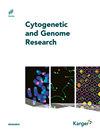急性髓细胞白血病9q染色体间质缺失的基因组学特征
IF 1.7
4区 生物学
Q4 CELL BIOLOGY
引用次数: 0
摘要
9号染色体长臂间质缺失[del(9q)]是一种相当常见的与急性髓性白血病(AML)相关的细胞遗传学发现,约有2-5%的AML患者出现这种情况。然而,缺失的基因组特征在很大程度上仍然未知。利用染色体分析、单核苷酸多态性微阵列和下一代测序,我们对9名AML患者的del(9q)s和其他基因组变化进行了表征。我们发现了del(9q)s的几个明显特征。缺失的近端断点聚集在富含节段重复的2.5Mb区域内(chr9:68513625-70984372;GRCh37),这可能代表基因组重排的“热点”。然而,缺失的远端断点差异很大。此外,整个缺失区可分为14.4-Mb的近端组成区(chr9:70950015-85397699;9q21.11q21.32)和24.0-Mb的远端致癌区(chr9:85397700-109427261;9q21.32q31.1)。我们进一步在远端区确定了6.8-Mb的常见重叠缺失区(CODR)(chr9:90590650-97366400)。这种CODR携带多个基因,据报道这些基因参与了癌症的发病机制。del(9q)在AML中的预后价值显然取决于患者的额外基因组改变。本文章由计算机程序翻译,如有差异,请以英文原文为准。
Genomic Features of Interstitial Deletions of Chromosome 9q in Acute Myeloid Leukemia
Interstitial deletion in the long arm of chromosome 9 [del(9q)] is a fairly common cytogenetic finding associated with acute myeloid leukemia (AML), seen in approximately 2–5% of AML patients. However, the genomic features of the deletion remain largely unknown. Using chromosome analysis, single nucleotide polymorphism microarray, and next-generation sequencing, we characterized del(9q)s and other genomic alterations in 9 AML patients. We found several distinct features of the del(9q)s. The proximal breakpoints of the deletions are clustered within a 2.5-Mb region (chr9: 68,513,625–70,984,372; GRCh37) enriched with segmental duplications, which may represent a “hotspot” for genomic rearrangements. However, the distal breakpoints of the deletions vary significantly. In addition, the overall deleted region could be divided into a 14.4-Mb proximal constitutional region (chr9: 70,950,015–85,397,699; 9q21.11q21.32) and a 24.0-Mb distal oncogenic region (chr9: 85,397,700–109,427,261; 9q21.32q31.1). We further identified a 6.8-Mb common overlapped deletion region (CODR) in the distal region (chr9: 90,590,650–97,366,400). This CODR carries multiple genes that are reportedly involved in cancer pathogenesis. The prognostic value of the del(9q) in AML apparently depends on additional genomic alterations in the patients.
求助全文
通过发布文献求助,成功后即可免费获取论文全文。
去求助
来源期刊

Cytogenetic and Genome Research
生物-细胞生物学
CiteScore
3.10
自引率
5.90%
发文量
25
审稿时长
1 months
期刊介绍:
During the last decades, ''Cytogenetic and Genome Research'' has been the leading forum for original reports and reviews in human and animal cytogenetics, including molecular, clinical and comparative cytogenetics. In recent years, most of its papers have centered on genome research, including gene cloning and sequencing, gene mapping, gene regulation and expression, cancer genetics, comparative genetics, gene linkage and related areas. The journal also publishes key papers on chromosome aberrations in somatic, meiotic and malignant cells. Its scope has expanded to include studies on invertebrate and plant cytogenetics and genomics. Also featured are the vast majority of the reports of the International Workshops on Human Chromosome Mapping, the reports of international human and animal chromosome nomenclature committees, and proceedings of the American and European cytogenetic conferences and other events. In addition to regular issues, the journal has been publishing since 2002 a series of topical issues on a broad variety of themes from cytogenetic and genome research.
 求助内容:
求助内容: 应助结果提醒方式:
应助结果提醒方式:


